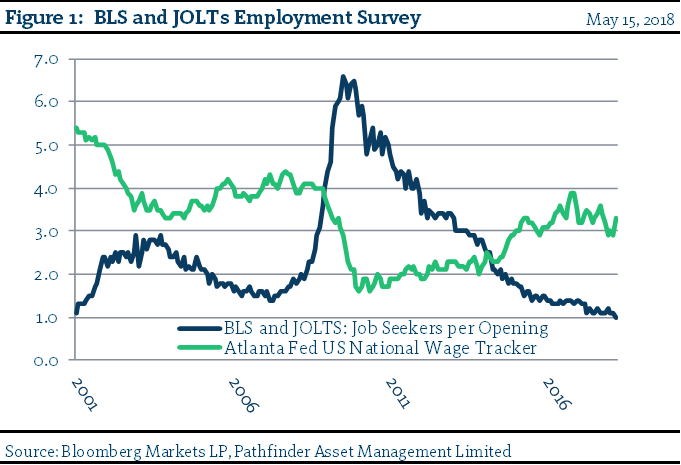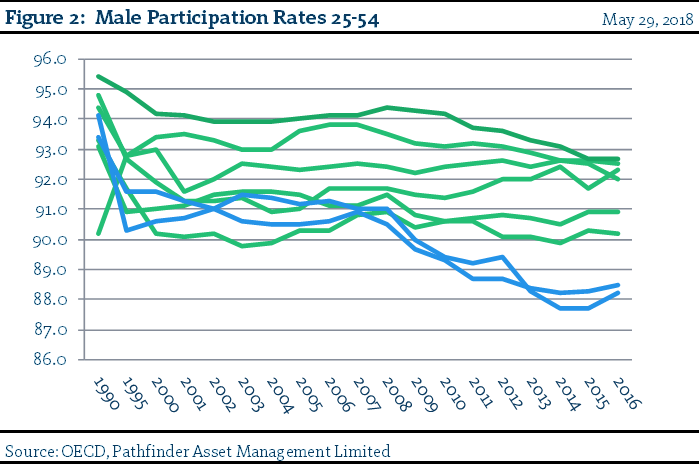Recap & Macro Outlook: Global Participation Rates
In our last issue, we wrote about the healthy environment for job seekers in the US. We saw participation rate data this week that added another layer to this discussion. We mentioned this in the past and thought that it would be appropriate to bring it up again. While it is true that the Unemployment Rate and “Seekers per Opening” metrics are at multi-decade lows (Figure 1), the participation rate in the US is also just bouncing off of a 2-decade low. The participation rate is a measure of those who are active in the job force – either currently working or actively looking for a job. While we did point out last week that there is a job for everyone who is looking for one, it also needs to be noted that only 82% of people between the ages of 25 and 54 are actually looking for work. That is, 18% of prime working age people have removed themselves from the workforce for various reasons (have gone back to school or have just given up, for example). If 100% of these people began actively looking for work, the current employment situation would not be as strong.

This got us thinking about the data in Figure 2 which presents Prime-age Male Participation rates from the early 1990’s for Countries like Canada, UK, France, Australia and Germany in the green and the US and Italy in the blue. What we noted was the large difference between the participation rates for these two countries. Most of the “green” countries are essentially flat over the 25-year period, while the “blues” are down about 6%. Last week, Italy popped to the top of the macro world with short-term government bond rates having a substantial one-day move after a failed attempt at a coalition government prompted a potential populist change, which would signal more EU drama, throwing “European Crisis” headlines back onto the front page.

“This means that” we do not see a recession in the short-term and as we have noted in previous Outlooks, as far as we can see, the economy in the US continues to expand.
National Instrument 31-103 requires registered firms to disclose information that a reasonable investor would expect to know, including any material conflicts with the firm or its representatives. Doug Johnson and/or Pathfinder Asset Management Limited are an insider of companies periodically mentioned in this report. Please visit www.paml.ca for full disclosures.
*All returns are time weighted and net of investment management fees. Returns from the Pathfinder Partners’ Fund and Partners’ Real Return Plus Fund are presented based on the masters series of each fund. The Pathfinder Core: Equity Portfolio and The Pathfinder Core: High Income Portfolio are live accounts. These are actual accounts owned by the Pathfinder Chairman (Equity) and client (High Income) which contain no legacy positions, cash flows or other Pathfinder investment mandates or products. Monthly inception dates for each fund and portfolio are as follows: Pathfinder Core: Equity Portfolio (January 2011), Pathfinder Core: High Income Portfolio (October 2012) Partners’ Fund (April 2011), Partners’ Real Return Plus Fund (April, 2013), and Partners’ Core Plus Fund (November 2014).
Pathfinder Asset Management Limited (PAML) and its affiliates may collectively beneficially own in excess of 10% of one or more classes of the issued and outstanding equity securities mentioned in this newsletter. This publication is intended only to convey information. It is not to be construed as an investment guide or as an offer or solicitation of an offer to buy or sell any of the securities mentioned in it. The author has taken all usual and reasonable precautions to determine that the information contained in this publication has been obtained from sources believed to be reliable and that the procedures used to summarize and analyze such information are based on approved practices and principles in the investment industry. However, the market forces underlying investment value are subject to sudden and dramatic changes and data availability varies from one moment to the next. Consequently, neither the author nor PAML can make any warranty as to the accuracy or completeness of information, analysis or views contained in this publication or their usefulness or suitability in any particular circumstance. You should not undertake any investment or portfolio assessment or other transaction on the basis of this publication, but should first consult your portfolio manager, who can assess all relevant particulars of any proposed investment or transaction. PAML and the author accept no liability of any kind whatsoever or any damages or losses incurred by you as a result of reliance upon or use of this publication.